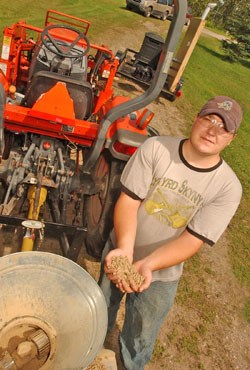NEWS RELEASE
LAKE SUPERIOR STATE UNIVERSITY
*************************** LSSU biology professor, student turn grass into fuel
SAULT STE. MARIE, MI - Lake Superior State University, a place already known for research in various fields of study, is the site of a new research project for alternative fuel sources.
The multi-phase project, led by LSSU biology department head Gregory Zimmerman Ph.D. with help from Justin Wilson, a senior environmental science major from Sault Ste. Marie, is studying the potential of reed canary grass pellets as an environmentally friendly and economical heating fuel, as well as a possible economic stimulant for the Eastern Upper Peninsula.
The grass being used in the study is known as reed canary grass, an abundant but weedy species in the EUP considered by many to be a problem due to its aggressive growth.
The first phase of the study wanted to prove the grass's practicality as a pellet fuel.
The recently completed second phase demonstrated how the grass could be made into small pellets as fuel for heating spaces such as a house.
Both phases have shown the grass pellets to have several potential benefits.
"Reed canary grass is a sustainable source of heating fuel, does not compete with food production and, compared to the use of fossil fuels, reduces the release of greenhouse gases," said Zimmerman, who added that he hopes the rest of the study will confirm the grass pellets' numerous advantages over current fuels such as propane.
To make the grass into pellets, Zimmerman harvested reed canary grass from a local field last November.
He chose this time period so that the grass was dead, allowing nutrients to move back to the soil and requiring no further energy for drying.
The collected grass was then ground into quarter-inch particles in a hammer mill.
The grass, along with various additives, was then sent through a small pellet mill driven by the PTO of a tractor.
After the grass was turned into pellets, the pellets were used in a multi-fuel stove.
The result of these grass pellets appears to be an effective and environmentally friendly source of heat.
Zimmerman and Wilson tried a variety of recipes to discover which additives would give reed canary grass pellets characteristics similar to those of wood pellets.
After multiple trials, the two recipes which produced the best results were not what one might expect.
One recipe mixed reed canary grass with spent brewer's grain, which was grain used during the beer-making process at Tahquamenon Brewery.
Another recipe called for the grass to be mixed with a small amount of fryer grease from LSSU's Quarterdeck cafeteria and corrugated cardboard.
Although time-consuming and difficult at points, Zimmerman said the recipe experimentation was essential to the success of making these pellets.
Zimmerman also acknowledges the generosity of the staff at LSSU's physical plant as a reason for the study's accomplishments.
The current location of the project and where the process of making pellets occurs is the garage behind the university's physical plant.
The staff of the plant has allowed Zimmerman and Wilson access to the garage during the course of the project in addition to other logistical help.
Zimmerman has been grateful for the staff's help through all phases of the study and says that they deserve a "big thanks."
The first two phases of the study were funded by the Biomass Energy Program of the Michigan Department of Energy, Labor, and Economic Growth.
Although he is preparing for the third phase, Zimmerman has already found one major economic advantage based on results from the first two phases.
"Based on an average of six fields in the EUP, three acres of reed canary grass would make enough pellets to replace 800 gallons of propane."
He said that he hopes the next phase, which could also be funded by a grant, will show that grass pellets are competitive with wood pellets while confirming the cost of making and using the pellets to be much less expensive than propane.
The ideal situation of study for this phase would involve a co-op of area farmers sharing the cost of a "pelletizer" and the effort taken to market the reed canary grass pellets to area residents and businesses.
He believes that keeping the co-op local could reduce transportation costs to ship the pellets and could also reduce the cost of heating for farmers, businesses, and residents.
In addition to planning the next phase of the study, Zimmerman and Wilson have been busy demonstrating how well reed canary grass pellets work to various community organizations.
LSSU's Board of Trustees, local conservation groups, and visitors to the Sault Ste. Marie Farmers' Market are just some of the area residents who have seen how these pellets work in a multi-fuel stove.
Future plans for Zimmerman and Wilson include continuing their demonstrations to residents throughout the area.
They will also repeat the pellet-making process in the fall.
For more information on upcoming demonstrations by Zimmerman and Wilson, or for information on how the project is moving along, keep checking LSSU's website for updates at www.lssu.edu.
***************************
